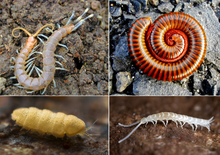Myriapod
| Myriapods Temporal range: Late Silurian–Recent |
|
|---|---|
 |
|
| Representatives of the four extant myriapod classes. Clockwise from top left: Chilopoda, Diplopoda, Symphyla, and Pauropoda. | |
| Scientific classification | |
| Kingdom: | Animalia |
| Phylum: | Arthropoda |
| Subphylum: |
Myriapoda Latreille, 1802 |
| Classes | |
Myriapoda is a subphylum of arthropods containing millipedes, centipedes, and others. The group contains over 13,000 species, most of which are terrestrial. Although their name suggests they have myriad (10,000) legs, myriapods range from having over 750 legs (the millipede Illacme plenipes) to having fewer than ten legs.
The fossil record of myriapods reaches back into the late Silurian, although molecular evidence suggests a diversification in the Cambrian Period, and Cambrian fossils exist which resemble myriapods. The oldest unequivocal myriapod fossil is of the millipede Pneumodesmus newmani, from the late Silurian (428 million years ago). P. newmani is also important as the earliest known terrestrial animal. The phylogenetic classification of myriapods is still debated.
The scientific study of myriapods is myriapodology, and those who study myriapods are myriapodologists.
Myriapods have a single pair of antennae and, in most cases, simple eyes. The mouthparts lie on the underside of the head, with an "epistome" and labrum forming the upper lip, and a pair of maxillae forming the lower lip. A pair of mandibles lie inside the mouth. Myriapods breathe through spiracles that connect to a tracheal system similar to that of insects. There is a long tubular heart that extends through much of the body, but usually few, if any, blood vessels.
...
Wikipedia
